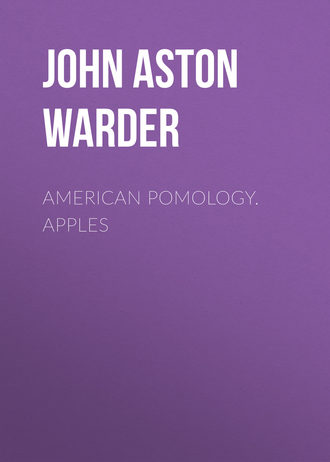 полная версия
полная версияAmerican Pomology. Apples
Another apple of similar and equally high character. Origin, Brooke County, Virginia. Introduced to the State Pomological Society by our zealous fellow member S.B. Marshall, Massillon, Ohio, who obtained it from N. Wood, of Belmont County.
Tree vigorous, healthy, spreading, productive, bears early; Shoots stout, dark; Foliage abundant, dark green.
Fruit full medium, cylindrical, regular; Surface yellow, vein-russeted; Dots numerous, minute.
Basin abrupt, folded; Eye large, closed.
Cavity wide, regular, green; Stem long, curved.
Core small, pyriform, closed, meeting the eye; Seeds numerous, plump, brown; Flesh yellow, firm, breaking, very fine-grained, juicy; Flavor sub-acid, aromatic, spicy, rich, refreshing; Quality very best; Use, dessert, too good for aught else; those who have tried it say that it is excellent for cooking; Season, January to March.
Kirkbridge White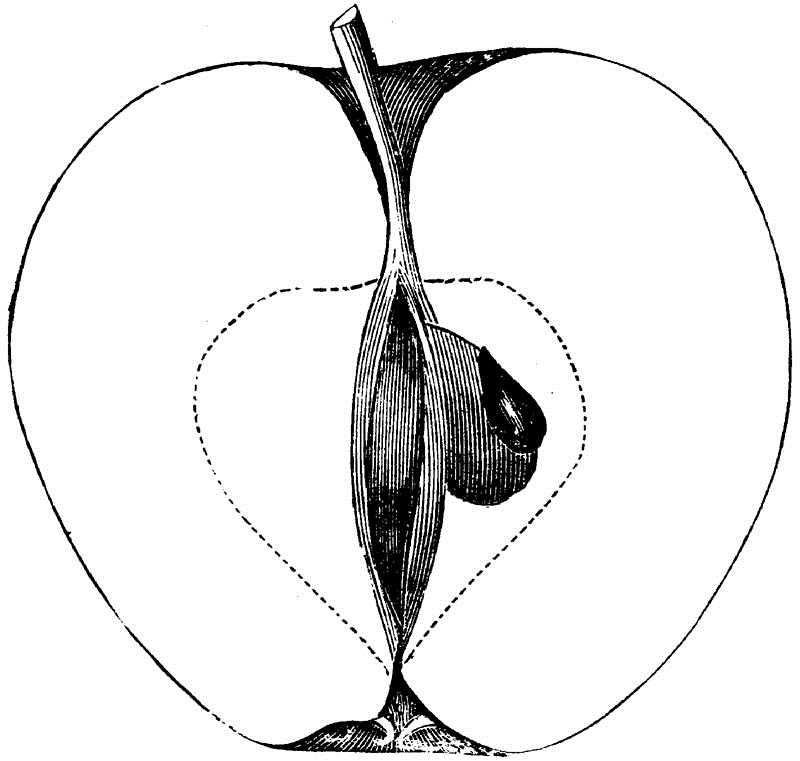
Fig. 275.—KIRKBRIDGE WHITE.
This fruit has been pretty extensively cultivated in some parts of the Western States, and sometimes mistaken for the Yellow June. Tree of moderate growth, bears early, productive.
Fruit small, oblong-conic, regular; Surface smooth, pale yellow or white; Dots minute, gray, scattered.
Basin small, shallow or abrupt, narrow, regular; Eye small, closed; Segments reflexed.
Cavity deep, acute, regular, brown; Stem long, slender, green.
Core medium, pyriform, regular, open, meeting the eye; Seeds numerous, plump, pointed, brown; Flesh white, fine-grained, tender, juicy; Flavor sub-acid; Quality very good; Use, table, market; Season, July, August, after Early Harvest.
OrtleyWHITE BELLFLOWER, And Many Others
Fig. 276.—ORTLEY.
This excellent New Jersey apple has been cultivated very satisfactorily over a great extent of our country, and is still seen in some Western collections, exhibiting all its peculiar beauty, but in many places where it was a great favorite but a few years since, it has become so defective from scab and bitter-rot that it is rapidly disappearing from the nurseries and orchards.
Tree vigorous, healthy, upright, becoming large and spreading, very productive; Shoots stout, dark, bearing limbs brittle, and often broken by the fruit.
Fruit large, oblong, conic, truncated, regular; Surface smooth, pale yellow, rarely blushed light carmine, and red spots; Dots minute, indented, white bases seen only in the unripe fruit.
Basin medium, regular, plaited; Eye small, very long, closed.
Cavity deep, acute, regular, brown; Stem long, slender.
Core medium, oval, regular, open, meeting the very long eye; Seeds numerous, short, plump, pointed, dark, easily loosened, when they rattle in the large open capsules; Flesh yellowish, tender, breaking, juicy; Flavor acid to sub-acid, sprightly, refreshing; Quality best; Use, table, kitchen; Season, November to January.
The threatened failure of this fine fruit is much to be regretted. Its tissue is so fine as to suit even the invalid or convalescent, who could not safely partake of a more solid apple.
Porter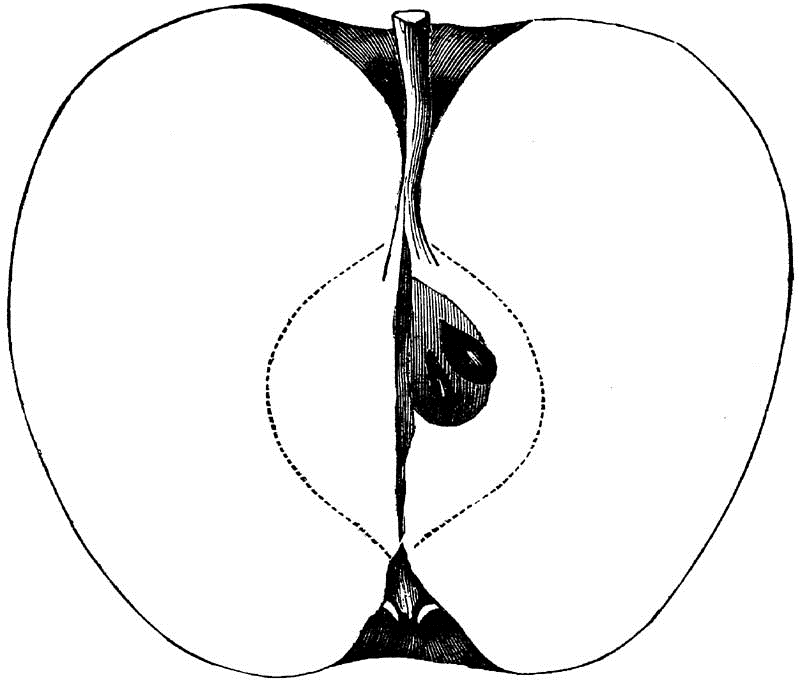
Fig. 277.—PORTER.
Native of Sherburne, Massachusetts. Tree vigorous, healthy, productive.
Fruit rather large, oblong, somewhat conic, often truncated; Surface smooth, yellow, often faintly blushed; Dots few, sunken.
Basin abrupt, folded; Eye large, closed.
Cavity acute, wavy, brown; Stem medium.
Core medium, oval, regular, closed, meeting the eye; Seeds numerous, plump; Flesh yellowish white, breaking, tender, juicy; Flavor acid to sub-acid; Quality good to very good; Use, kitchen, table, market; Season, August to October.
Spark'sSPARK'S LATE
Fig. 278.—SPARK'S.
Fruited by Jas. H. Crain, of Undulation, Pulaski County, Illinois, on trees received from J.W. Felt & Co., Crystal Springs, Mississippi.
Special origin unknown, but believed to be southern. Tree vigorous, upright and productive; Shoots stout.
Fruit full medium to large, oblong, conic, regular, handsome; Surface greenish-yellow; Dots numerous, rather large, gray and rough.
Basin shallow, small, regular; Eye very small, closed.
Cavity deep, acute, regular, green; Stem medium to long.
Core medium, oval, closed, meeting the eye; Seeds numerous, plump; Flesh yellow, breaking, fine-grained, juicy; Flavor sub-acid, rich, very aromatic; Use, dessert especially; Season, December and January; Quality best.
CLASS IV.—OBLONG APPLESORDER I.—REGULARSECTION 2.—SOURSUB-SECTION 2.—STRIPEDBoalsburg"A seedling of Center County, Pennsylvania. Large, oblong, inclining to conical, delicately mottled, and striped with red on yellow ground; Stem short, thick, inserted in a deep, acuminate, russeted cavity; Basin deep, moderately wide; Flesh yellow, juicy, sprightly, refreshing; Very good; February."—[Ad interim Reports.]
Mr. Waring, of Tyrone, Pennsylvania, writes me that the Boalsburg has not proved to be productive, and that he has discontinued its propagation.
Cannon Pearmain
Fig. 279.—CANNON PEARMAIN.
A southern apple; probably from North Carolina. Grown to some extent in parts of the West, where it proves a substitute for the Ben Davis, keeping longer.
Tree vigorous, healthy, productive when old; Fruit medium, round, oblong or ovate, regular; Surface smooth, yellow, shaded red, faintly striped; Dots large, yellow, gray.
Basin deep, abrupt, regular, rarely wavy; Eye small, closed.
Cavity acute, often lipped; Stem long, slender, red.
Core medium, regular, oval, closed, clasping; Seeds numerous, long, pointed; Flesh yellow, firm, breaking; Flavor mild sub-acid; Quality only good; Use, market, kitchen, table; Season, January to April.
Cooper's Market"Tree vigorous, upright, with long, slender branches; productive and a late keeper.
"Fruit medium, oblong, conic; Skin yellowish, shaded with red, striped crimson; Stem short; Cavity deep, narrow; Calyx closed; Basin small; Flesh white, tender, with a brisk, sub-acid flavor; December to May."—[Downing.]
Fall Butter.—[L. Jones.]50There are many apples with this name, but my good friend Lewis Jones thinks this is the only genuine kind, and deserving the name from its adaptation to the making of apple butter. Found in a seedling orchard of Eastern Indiana, and a distinct sort.
Fruit large, handsome, globular; Surface smooth, greenish-yellow; Dots minute, prominent.
Basin regular, abrupt, brown; Eye medium, closed.
Cavity deep, narrow, green; Stem short.
Core medium, round, open, clasping; Seeds numerous, short, plump, dark; Flesh yellowish-white, breaking, fine-grained, juicy; Flavor sweet; Quality best for table, baking and apple butter; Season, December and January.
Hague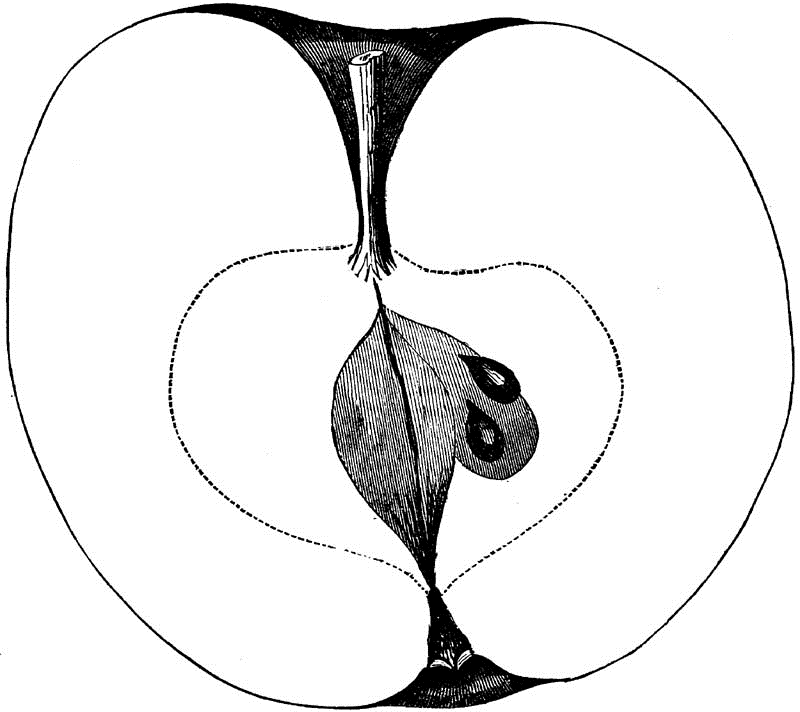
Fig. 280.—HAGUE.
Introduced by Lewis Jones, Wayne County, Indiana. Believed to be a seedling.
Fruit large, roundish, oblong, cylindrical, truncate; Surface smooth, greenish yellow, shaded more or less with red, striped and splashed deep red; Dots numerous or scattered, large, distinct, yellow.
Basin medium, regular; Eye medium, closed.
Cavity deep, acute, regular, brown; Stem short to medium, curved.
Core large, heart-shaped, regular, closed or open, clasping; Seeds numerous, short, pointed, plump; Flesh yellow, tender, fine-grained, juicy; Flavor sub-acid, aromatic, rich; Quality very good to best; Use, table, market; Season, December to February. Worthy of attention.
Herman"From Cumberland County, Pennsylvania. Tree vigorous, spreading, quite prolific.
Fruit medium, oblong, conic; fine red, striped on green, Flesh greenish white, tender, juicy, sub-acid, and high flavor; November to April."—[Saml. Miller, in Downing.]
Indiana Beauty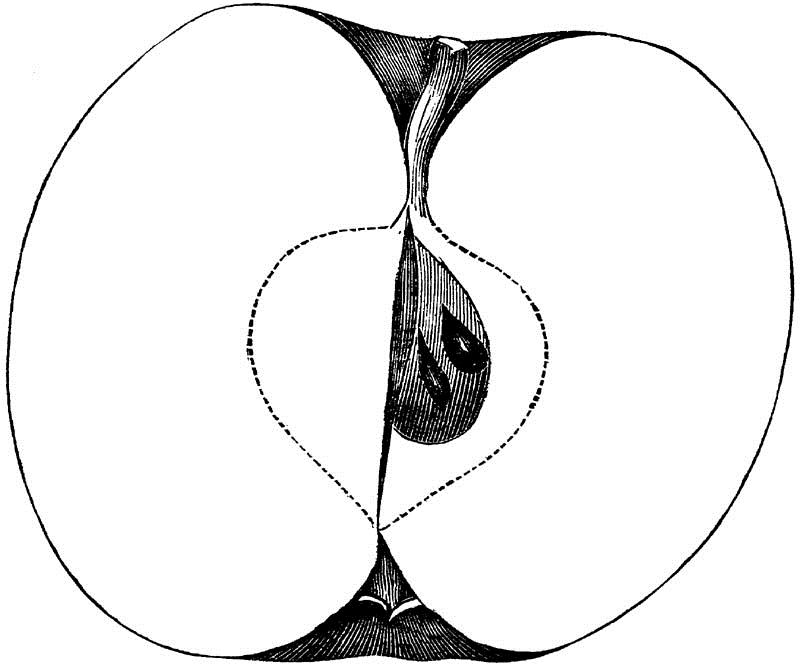
Fig. 281.—INDIANA BEAUTY.
This beautiful Indiana seedling always attracts attention by its external appearance, but it is not destined to become a general favorite.
Fruit large, cylindrical, oblong, unequal; Axis inclined; Surface very smooth yellow, partially covered mixed scarlet, splashed carmine; Dots numerous, small.
Basin deep, abrupt, folded; Eye medium to large, closed.
Cavity acute, wavy; Stem medium.
Core small, oval, closed, clasping the eye; Seeds numerous, long, pointed, imperfect; Flesh yellowish, breaking, juicy; Flavor sub-acid, aromatic; Quality only good; Use, market, kitchen; Season, September, November.
Jonathan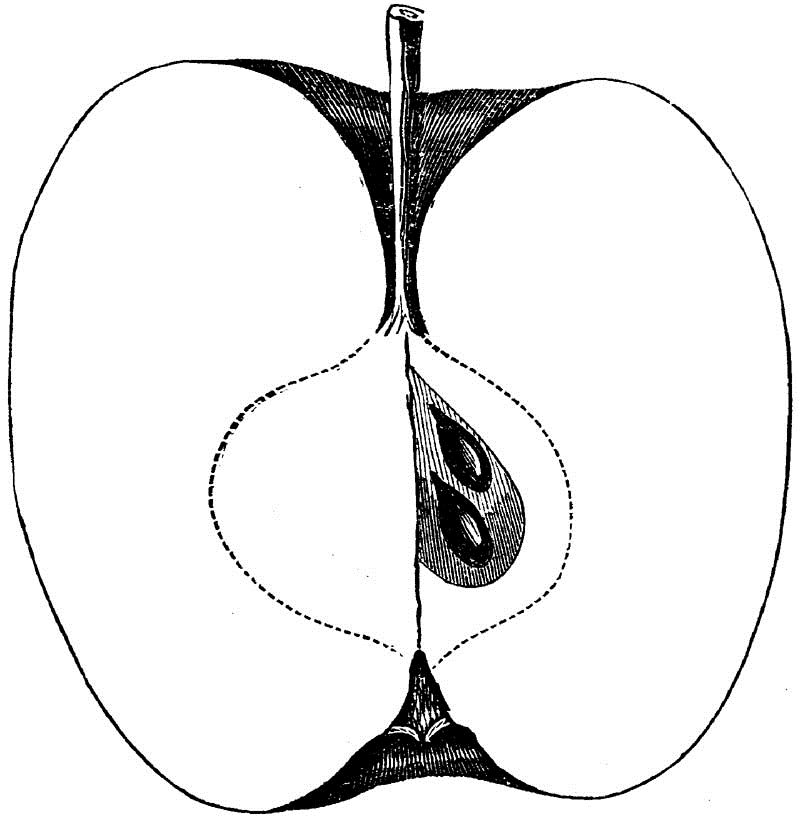
Fig. 282.—JONATHAN.
Origin, Kingston, New York. Described by Judge Buell. A very superior dessert fruit; good for all purposes, and seems to do well everywhere. Its excellence has caused it to be called, particularly, a gentleman's apple, though quite acceptable to the farmers' boys.
Tree of rather slender growth; hence top-grafted in the orchard and stock-grafted in the nursery to produce early results; Spreading, rather drooping, productive; Shoots slender, light brown, buds small; Foliage rather sparse, grayish.
Fruit medium, round or oblong, conic, truncated, regular; Surface very smooth, waxy yellow, wholly covered brilliant dark red, mixed and striped; Dots minute, russet-veined.
Basin deep, regular, russet-veined; Eye small, closed, green.
Cavity acute, deep, regular, reddish brown; Stem long, slender.
Core medium, roundish-oval, regular, closed, scarcely clasping the eye; Seeds numerous, large, angular; Flesh, whitish yellow, tender, breaking, very juicy; Flavor sub-acid, aromatic, equal to Spitzenberg; Quality best; Use, dessert, cooking, &c.; December, January.
Should be in every orchard.
Kaighn's Spitzenberg.—[Coxe.]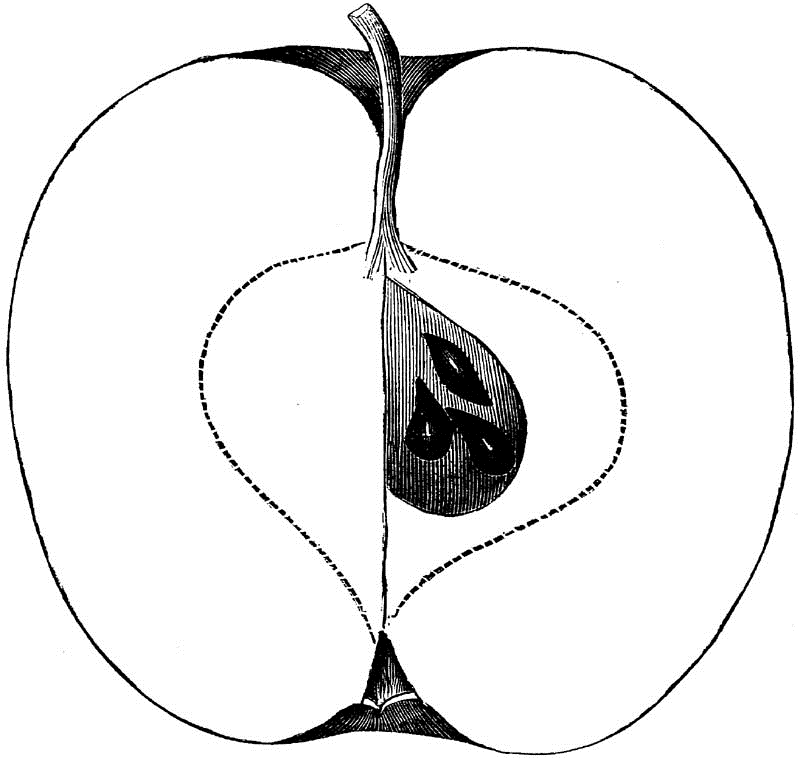
Fig. 283.—KAIGHN'S SPITZENBERG.
From Gloucester County, New Jersey. Tree spreading, very productive; Shoots slender.
Fruit large, handsome, oblong, slightly conic, truncated, regular; Surface smooth, yellow, striped crimson; Dots minute.
Basin deep, abrupt, folded or regular; Eye medium, closed; Segments reflexed.
Cavity deep, acute, regular, brown; Stem long, slender, red.
Core large, pyriform, regular, clasping, generally open; Seeds numerous, plump, angular, loose; Flesh yellow, breaking, juicy; Flavor acid to sub-acid, rather rich; Quality good for culinary use; Market and drying; Season, November, December.
Knowles' EarlyA favorite early apple about Philadelphia. Origin supposed to be Bucks County, Pennsylvania.
Tree medium, thrifty, very productive, early bearer.
Fruit small, conical, oblong, striped dull red on yellow.
Basin shallow, plaited; Eye small, closed.
Cavity acute, regular; Stem medium to long.
Flesh yellowish, very tender, juicy; Flavor mild sub-acid, aromatic, agreeable; Quality good; Use, table, kitchen; Season, July and August.
Long Island Pearmain.—[Coxe.]AUTUMN PEARMAIN, Thompson, according to Downing.—WINTER PEARMAIN, Western marketsAn old variety found in all the early orchards of Ohio and Indiana, that were within the influence of Silas Wharton's nursery. A good, profitable variety that has been overlooked in the rage for novelties.
Tree large, spreading, very productive; Fruit full medium, round, elongated, tapering slightly from the base, always truncated at the apex, regular; Surface smooth, yellowish green, covered with dull red, and striped maroon; Dots numerous, minute, gray; russet-veined towards the base.
Basin regular, wide, rather deep, slightly leather-cracked; Eye medium, open; Segments long.
Cavity rather wide; Stem long.
Core medium, heart-shaped, regular, closed, not clasping; Seeds numerous, large, plump, brown;. Flesh yellow, breaking, firm, not very juicy; Flavor sub-acid, aromatic, rich, agreeable; Quality good; Use, family and market; Season, November till March.
Marston's Red WinterAs I have never seen this fruit, I again quote from Downing:
"I received this beautiful apple from Nathan Norton, of Greenland, New Hampshire, who said the original tree was more than a hundred years old, and still standing.
"Tree hardy, of moderate growth, great bearer, and keeps as well as Baldwin, and by many preferred to that variety, and is a popular fruit in the neighborhood.
"Fruit above medium size, oblong, oval, inclining to ovate; Stem three-quarters of an inch long, rather slender, in a narrow, deep, compressed, slightly russeted cavity, sometimes with a lip; Calyx partially closed; Segments long, in a deep, corrugated basin; Color whitish yellow, shaded and striped with bright green and crimson, thickly sprinkled with minute dots; Flesh whitish yellow, very juicy, tender, sprightly, sub-acid flavor; December to March."
Mifflin KingOrigin Mifflin County, Pennsylvania. Fruit small, color of Rambo perhaps a trifle more red, oblong; Flesh remarkably tender, juicy and pleasant; First rate.—[American Pomological Society's Report.]
CLASS IV.—OBLONG APPLESORDER I.—REGULARSECTION 2.—SOURSUB-SECTION 3.—RUSSETNoneCLASS IV.—OBLONG APPLESORDER II.—IRREGULARSECTION 1.—SWEETSUB-SECTION 1.—SELF-COLOREDSweet Bellflower
Fig. 284.—SWEET BELLFLOWER.
This apple is supposed to have originated in the neighborhood of Dayton, Ohio, and is cultivated chiefly in the adjacent regions, and when found elsewhere is traceable to this source.
Fruit large, roundish oblong, angular; Surface uneven, greenish yellow, becoming creamy yellow, very rarely blushed or bronzed; Dots minute, indented, surrounded by green in the unripe fruit.
Basin medium, folded; Eye small, closed; Segments long, reflexed.
Cavity acute, wavy, green; Stem long, slender.
Core regular, roundish, open, meeting the eye; Seeds numerous, plump, angular, imperfect; Flesh white, fine-grained, breaking, juicy; Flavor very sweet; Quality good to very good; Use, baking, table; Season, December.
Not equal to Broadwell.
CLASS IV.—OBLONG APPLESORDER II.—IRREGULARSECTION 1.—SWEETSUB-SECTION 2.—STRIPEDHarnish"From Lancaster County, Pennsylvania. Fruit medium, oblong, oval, slightly angular; Skin mostly shaded with dark red, and sprinkled with grayish dots; Flesh compact, tender, not juicy, almost sweet, pleasant; September to October."—[Downing.]
Illinois Pumpkin Sweet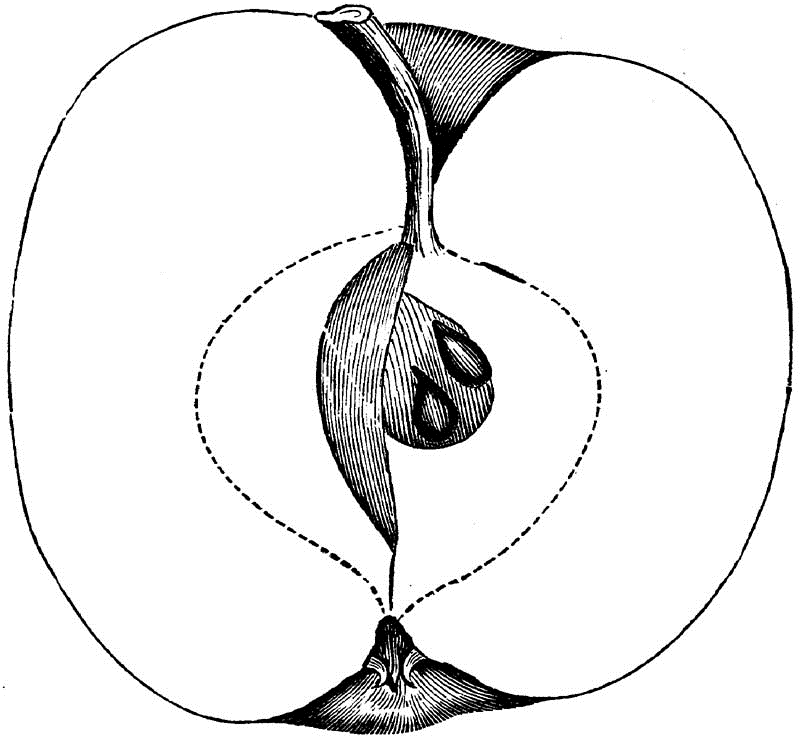
Fig. 285.—ILLINOIS PUMPKIN SWEET.
This apple was found in Illinois. From the orchard of Mr. Montagu, who esteemed it very highly.
Fruit medium, oblong, ovate, angular; Surface mixed, splashed and striped with dull red; Dots scattered, distinct, yellow.
Basin abrupt, folded; Eye medium, closed.
Cavity acute, folded; Stem medium, inclined.
Core medium, pyriform, regular, closed, clasping; Seeds numerous, angular, plump; Flesh yellow, rather tough in winter, but "becomes melting in June"; Flavor very sweet; Quality good, Montagu says best; Use, kitchen, table; Season, January till June.
CLASS IV.—OBLONG APPLESORDER II.—IRREGULARSECTION 1.—SWEETSUB-SECTION 3.—RUSSETNoneCLASS IV.—OBLONG APPLESORDER II.—IRREGULARSECTION 2.—SOURSUB-SECTION 1.—SELF-COLOREDGenesee Chief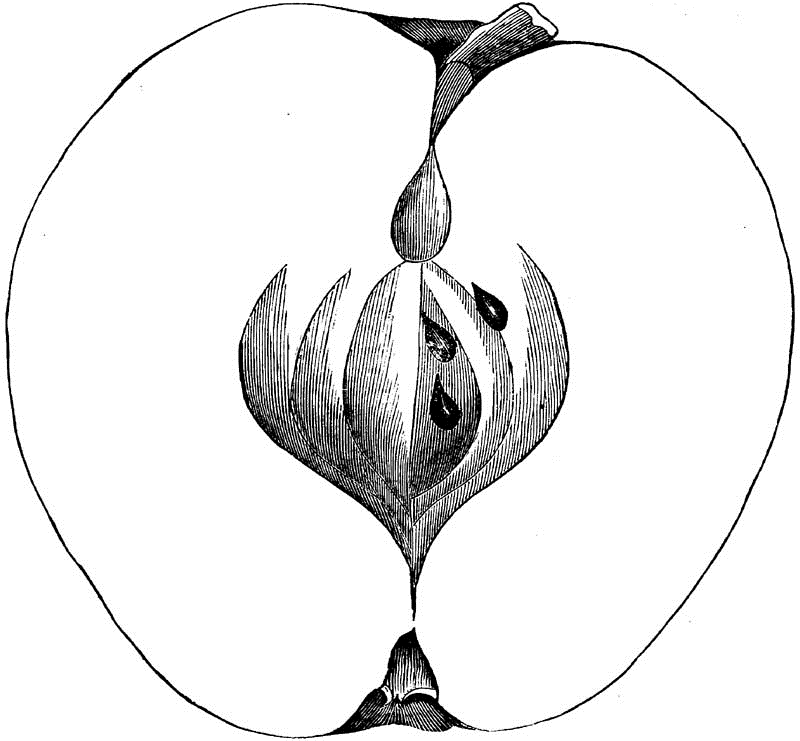
Fig. 286.—GENESEE CHIEF.
Fruit large to very large, roundish oblong, ribbed or angular; Surface smooth, pale yellow, sometimes bronzed; Dots scattered, minute.
Basin shallow, medium; Eye small, but very long, closed.
Cavity narrow, pointed, green; Stem medium, knobby.
Core very large, round, clasping, very open; Seeds numerous, defective, angular, brown; Flesh white, tender, breaking, juicy; Flavor acid, thin; Quality second rate—good only for cooking; Season, August.
Henwood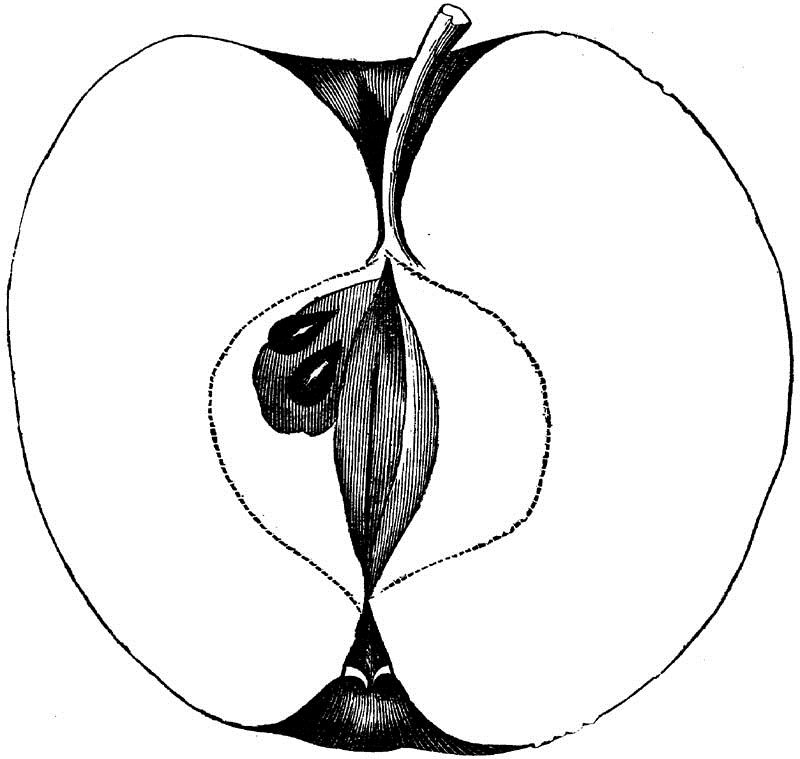
Fig. 287.—HENWOOD.
A seedling of Indiana. Brought into notice by Lewis Jones, of Wayne County, who has frequently exhibited the fruit, and distributed grafts of this excellent apple, which may compensate for the failure of its reputed parent, the Ortley.
Fruit large, oblong, conic or ovate, often angular or ribbed; Surface smooth, pale yellow, rarely blushed; Dots scattered, dark.
Basin shallow, often abrupt, folded or plaited; Eye small, closed.
Cavity deep, acute, wavy; Stem long, slender.
Core rather small, round, regular, open, meeting the eye; Seeds numerous, long, angular; Flesh yellow, tender, fine-grained, juicy; Flavor acid to sub-acid, rich; Quality very good to best; Season, December to February.
Keswick Codling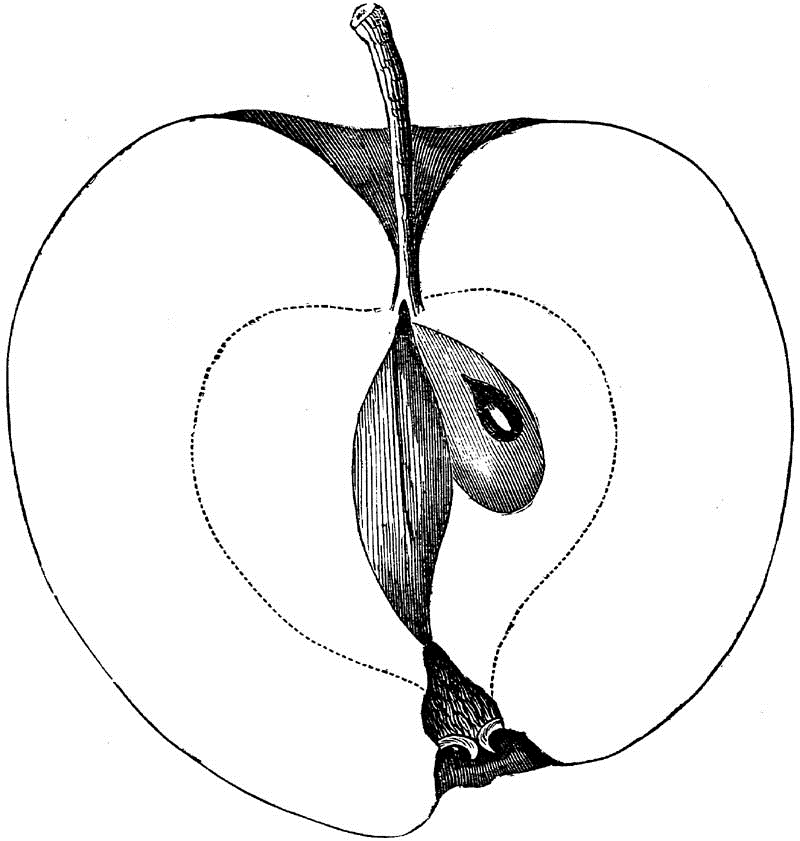
Fig. 288.—KESWICK CODLING.
An old English variety, which has greatly pleased the people of our country, who find it a valuable market and family fruit, particularly desirable in the North and Northwest.
Tree vigorous, hardy, productive, an early bearer; Shoots branching in a peculiar manner, dark.
Fruit medium, oblong, conical, truncated, ribbed; Surface smooth, pale yellow; Dots scattered, minute.
Basin medium, folded; Eye medium to large, closed.
Cavity acute, regular, browned; Stem long, yellow.
Core large, open, clasping; Seeds numerous, angular; Flesh greenish yellow, fine-grained, tender, juicy; Flavor acid; Quality good to very good for its use—cooking; Season, August to October.
The fruit may be cooked in June.
Newark Pippin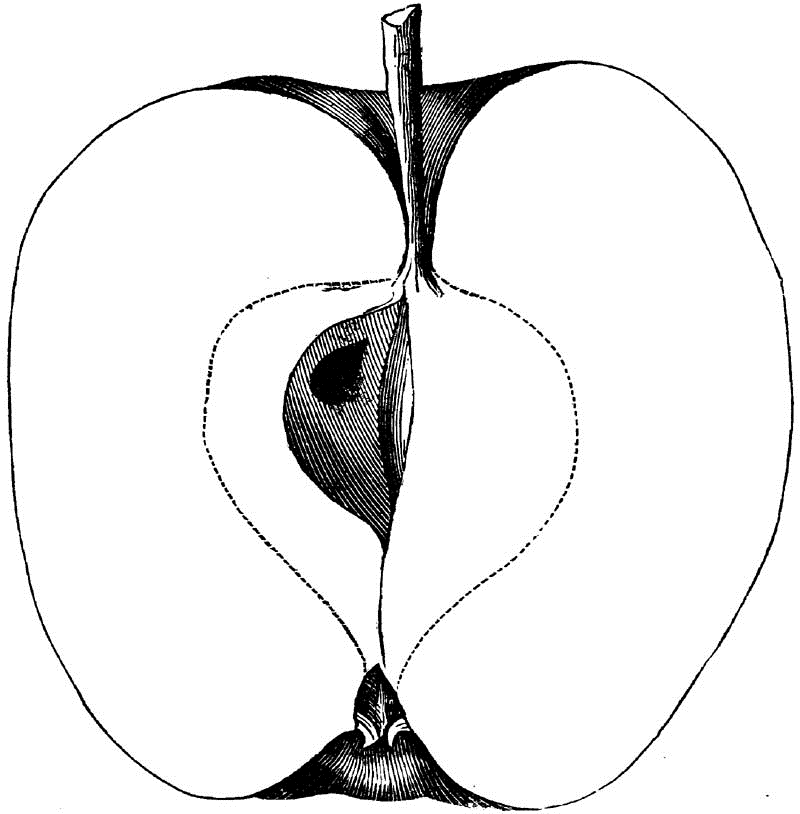
Fig. 289.—NEWARK PIPPIN.
Origin, New Jersey. Tree not large, brushy, limbs crooked, twiggy, drooping, not very productive or satisfactory.
Fruit above medium, oblong, cylindrical, truncated very abruptly, slightly angular; Surface smooth, rich yellow when ripe; Dots minute.
Basin wide, regular; Eye large, open.
Cavity wide, regular; Stem long, slender.
Core large, oval or pyriform, regular, closed, clasping; Seeds numerous, angular, plump; Flesh deep yellow, breaking, fine-grained, juicy; Flavor sub-acid, aromatic, rich, sprightly; Quality best; Use, dessert, cooking; Season, December to February.
A delicious fruit for amateurs, but its place is supplanted by Grimes' Golden, which is a much better tree, with fruit of similar good qualities, and better.
Rock PippinRIDGE PIPPIN, LEMON, &C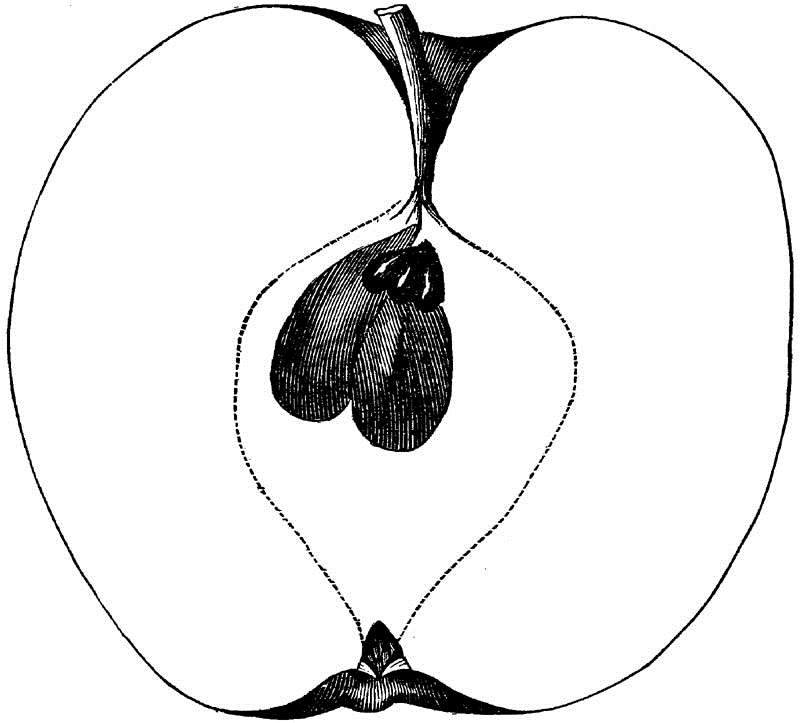
Fig. 290.—ROCK PIPPIN.
This admirable long-keeper has claims upon the attention of the commercial orchardist, on account of its soundness and beauty in the spring. Tree very thrifty, large, productive; Branches open, spreading; Shoots stout, dark; Foliage large, scattered.
Fruit full medium, oblong, ovate, angular, often ribbed, truncate at the apex, sometimes unequal; Surface very smooth, very rich yellow, blushed bright carmine when ripe; Dots few, small, dark.
Basin shallow, plaited or folded; Eye small, short, closed.
Cavity acute, often lipped; Stem medium.
Core medium, pyriform, open, somewhat clasping; Seeds numerous, long, brown; Flesh yellow, breaking, rather dry; Flavor acid to sub-acid, rich; Quality only good; Use, market and kitchen; Season, December to May; of most value to sell at the latter period.
Cooks well all winter.
Yellow Bellflower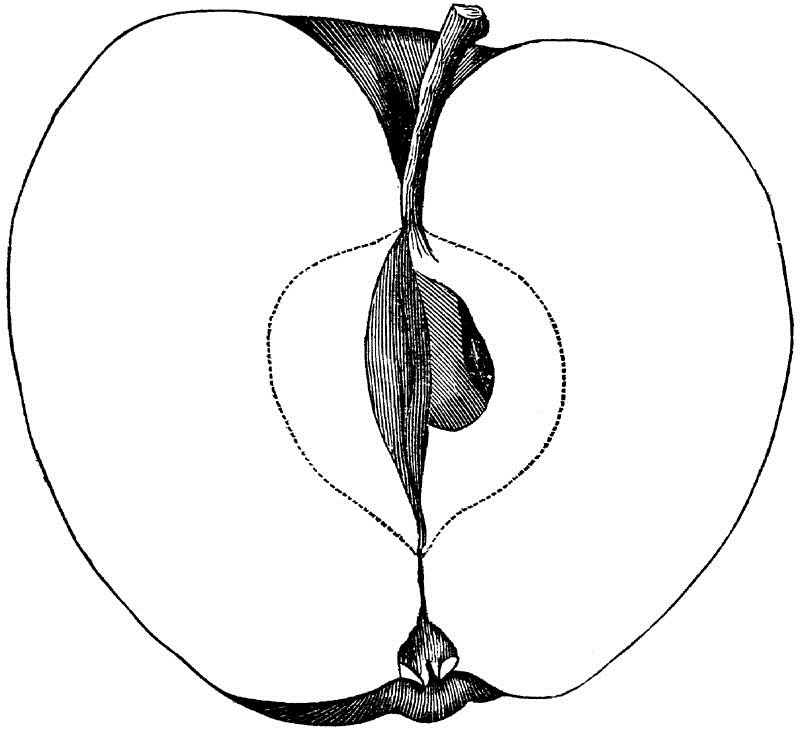
Fig. 291.—YELLOW BELLFLOWER.
This noble and valuable constituent of our orchards came from Burlington County, New Jersey, where it was first described by Coxe. This apple has succeeded in almost all parts of the country, North and South, and has proved remarkably hardy. The quality of the fruit varies with the soil, being best and most highly flavored and colored on exposed ridges of rather thin soil, while those on rich low bottoms or prairies are slow in bearing, and then produce very large fruit. The crops, however, are not always satisfactory in such situations, though the trees become very large; the blossoms are often destroyed by spring frosts.
Tree vigorous, thrifty, hardy, large, spreading, drooping; Twigs slender, brown; Foliage abundant, long, wavy; Blossoms very large, on long stems, exposed to the weather and not protected by the leaves.
Fruit large to very large, oblong, ovate, angular, ribbed; Surface smooth, rich yellow, sometimes blushed; Dots scattered gray.
Basin shallow or moderately deep, plaited or folded; Eye small, closed.
Cavity deep, acute or wide, wavy; Stem long, curved.
Core large, oval, open, clasping; Seeds dark, large, angular, imperfect; Flesh yellow, breaking, fine-grained, juicy; Flavor acid to sub-acid, aromatic, very rich and satisfying; Quality best; Use, table, kitchen, market; Season, December.
One of the finest culinary apples in the catalogue.
York ImperialFrom the neighborhood of York, Pennsylvania. Exhibited before the State Society at the meeting in Lebanon, 1855. Tree said to be healthy and productive.
Fruit large, rather oblong, somewhat angular; Surface smooth, mixed bright red on greenish yellow.
Basin wide, plaited; Eye medium, closed.
Cavity deep, wide; Stem short.
Flesh yellowish, tender, juicy; Flavor sub-acid, aromatic; Quality quite good; Use, market, kitchen; Season, January, February.
CLASS IV.—OBLONG APPLESORDER II.—IRREGULARSECTION 2.—SOURSUB-SECTION 2.—STRIPEDClyde Beauty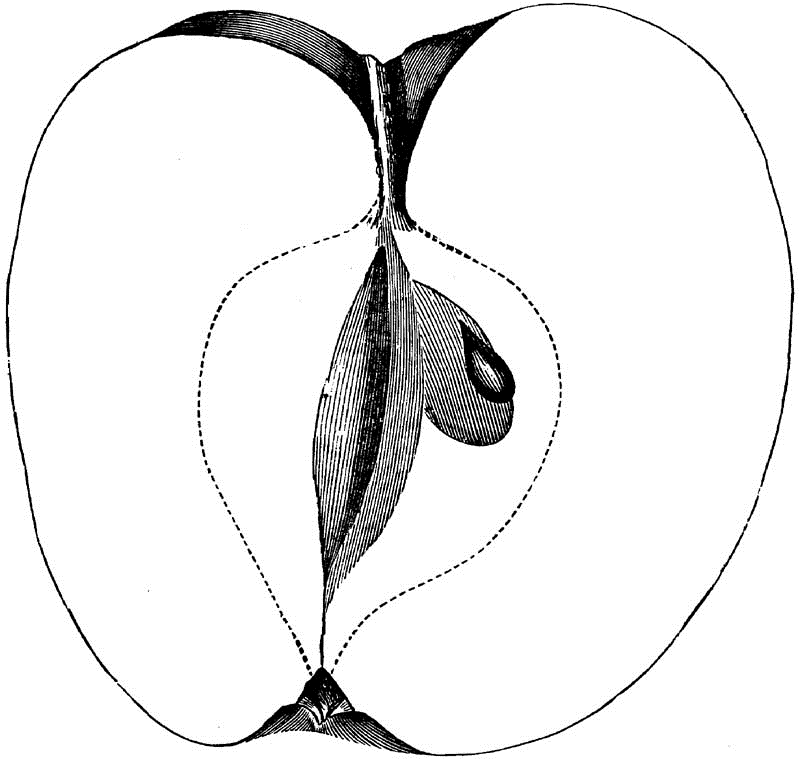
Fig. 292.—CLYDE BEAUTY.
"Origin, Wayne County, New York. Tree vigorous, upright, very productive.
"Fruit large, roundish, conic, angular; Skin greenish, oily, sprinkled and mottled with dull red, and bright red in the sun; Stem short, slender, inserted in an acute cavity; Calyx closed, set in a small corrugated basin; Flesh white, tender, juicy with a brisk sub-acid flavor; October to January."—[Downing.]
Frank or ChenangoCHENANGO STRAWBERRYThis beautiful apple has been called also the Late Strawberry. So, to avoid confusion, perhaps, it were better to adopt its local name Frank. It is a native of New York.
Fruit medium to large oblong, tapering, irregular; Surface smooth, beautifully striped on waxen yellow.
Basin folded and plaited, abrupt; Eye medium, closed.
Cavity acuminate; Stem medium.
Flesh tender, juicy; Flavor sub-acid, aromatic; Quality very good; Use, dessert; Season, autumn.
MinisterThis New England apple was introduced by Mr. Manning; when he brought it before the American Pomological Society, it met with so much favor from the members of that body that it was adopted and recommended. In the Western States it has failed to give satisfaction and is generally discarded, but further North it may do as well as in New England. In Ohio it becomes an autumn apple, and is only used for cooking, when we have plenty of others that are preferred.
Tree healthy, vigorous, early bearer, and constantly productive.
Fruit full medium to large, oblong, tapering to the eye, ribbed, irregular; Surface smooth, yellow, covered bright red mixed, splashed carmine, often handsome; Dots minute.
Basin very narrow, folded, plaited; Eye small, closed.
Cavity deep, acute, sometimes brown; Stem long, slender.
Flesh yellowish, breaking, juicy; Flavor acid; Quality only good; Use, kitchen; Season, September and later; not a winter fruit in latitude forty.
Striped Gilliflower
Fig. 293.—STRIPED GILLIFLOWER.

